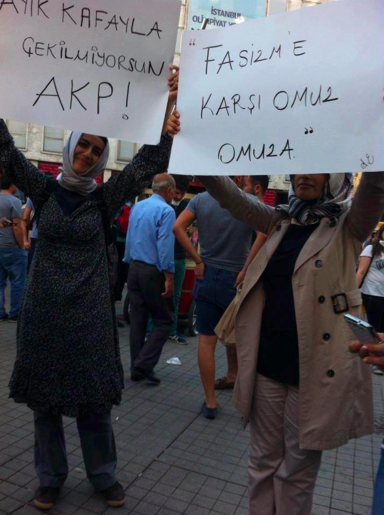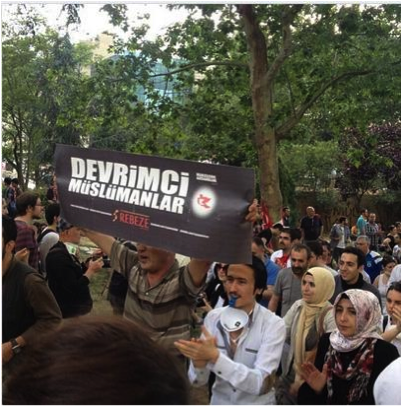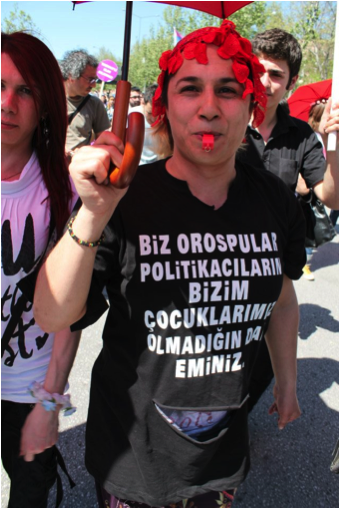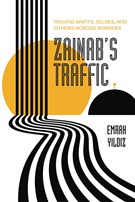Over ten thousand people took over the streets of Ümraniye, a working-class neighborhood on the Asian side of Istanbul, at around 10 pm on Sunday 2 July to stand in solidarity with the demonstrators not only in the grounds of the Gezi Park in Taksim Square, but also with those demonstrating in sixty-seven cities all over Turkey from Ankara and Izmir, to Adana and Hatay. Gathering on the main avenue of the May 1st Mahallesi (district) of Ümraniye, a neighborhood always imagined as a stronghold of AKP politics and home to a socially conservative lifestyle among the diverse districts of Istanbul, over ten thousand Ümraniye locals marched onto the main artery of Istanbul’s highway system connecting the European and Asian sides of the city via the Bosphorus Bridge, known as TEM in Turkey. Chanting the signature slogans of “shoulder to shoulder against fascism” and “resist Gezi [Park] resist!” of the demonstrations that ensued from Taksim square, the Umraniye locals formed a human blockade and closed the highway artery to traffic. Disregarding all signs alerting the drivers to the blockade miles ahead, a speeding black luxury car, described either as an Audi A6 or a BMW by eyewitnesses, ripped through the crowd, seriously wounding two peaceful demonstrators, associated with the Socialist Solidarity Platform, Sosyalist Dayanışma Platformu (SODAP) in Turkish. The 17-year-old SODAP member and high school student Sezgin Kartal remains in critical condition in Göztepe Eğitim ve Araştırma Hospital as I write this piece. The 19-year-old factory worker, and member of the socialist hackers’ network, Redhack, in Turkey, Mehmet Ayvalıtaş, on the other hand, has unfortunately passed away in the same hospital despite all the attempts to save his life.
While international media, and some analysts have focused on the festive and celebratory ambience of Taksim square in particular and have made sure to highlight the “upper-class” and “secularist” character of its occupants enjoying their victory over the police over the past two days, Mehmet’s heartbreaking story and his truncated biographical information point to a much more complex picture on the ground, illustrating not only why the people are in a rage, but also who in particular is in a rage. Not taking Mehmet’s story as a part and parcel of the “resistance” that sparked in Turkey, not only paves the way for the worst kind of epistemic violence unleashed in the idiom of armchair “political” analysis, but also unethical and irresponsible practices of representation. On both accounts, disavowing Mehmet’s story, and stories like his, also runs the risk of reproducing Erdogan’s dismissive and defiant characterization of the demonstrators as spoiled “freeloaders” (capulcu in Turkish) upset about “a few trees”, and drunkards (ayyas in Turkish) frustrated with the recently-amended new law on alcohol consumption, all managed and puppet-mastered by the main opposition party, the “elite” and “secularist” social democrats of Turkey.
As a native of Istanbul and an anthropologist working on Turkey and its regional connections, I am- for better or worse- quite familiar with Erdogan’s patronizing rhetoric of counter-attack, on which he forges manipulative narratives of atrocities committed under his administration. His attempts to redirect the public’s attention away from the Uludere/Roboski massacres of Kurdish villagers on the Iraq border by proposing a new anti-abortion law, or the “timely” amendment of the alcohol law right after the bombings that devastated Reyhanli on the Syrian border should suffice as cases in point for further reading for those unfamiliar with what I mean. To go back a bit further, calling Israel a “terrorist state” for killing Palestinian children one day, and ordering his own F-16s to kill Kurdish ones in Turkey’s Kurdistan might ring another bell and answer the aggravating question of “why are the people of Turkey so upset over a park?” Quite a few people have already written how and why this was not about a park, or trees or alcohol.
What is more upsetting to me, however, is the analytical myopia that underwrites the politics of naming what is happening and the actors who are doing the resisting in Turkey on the one hand, and the utter disregard for stories like that of Mehmet’s, since they do not neatly fit into the banally familiar and mutually exclusive positions of the entrenched elite secularists vs the overly-confident working-class Islamists in Turkey. The seemingly strange alignments the “resistance” has been breeding in Turkey should not be explained away in such abstract and categorical terms, but approached as vital social grounds through which we can rethink these categories, both in our representational practices and analytical endeavors. Mehmet’s story, peppered with information about where he comes from, his participation in Redhack while being a factory worker, for instance, might help us rethink not only the secularist elite/Islamist working-class binary, but also the assumed class positions of social media users and online activists in particular and the more abstract relationship between social class and technology in the age of late capitalism.

[Image of two women protesting in Taksim Square. Image from Ötekilerin Postası Facebook Page.]
Or take these two women wearing headscarves spotted at Taksim Square for instance. The banner that the woman on the left holds reads “Erdogan, you are unbearable when [I am] sober,” whereas the other one reads “shoulder to shoulder against fascism.” For those hardcore collectivists in the house who might read these lines and attempt to dismiss the assemblages of these religious women and their banners as random, misinformed or simply too few to say anything about the relationship between the “secular” pleasures of alcohol consumption, the practice of Islam and the politics of social freedoms in Turkey, you might want to check out the group called “Revolutionary Muslims” who are quite active on the ground in the Gezi Park. I will quote here in full, their message to Erdogan and his collaborators in misrepresentation, and- if I may add, those who suffer from analytical myopia:

[Image from Hadiye Facebook Page.]
Some news for the Prime Minister and his collaborators who try to reduce the resistance to a particular [secularist] political group and in so doing sow the seeds of polarization among us:
- It was the atheists who formed a human blockade around those praying in the [Taksim] Square.
- It was the soccer fans of Galatasaray who resisted the police attempts to detain the fans of Fenerbahçe.
- Socialist victory arks and nationalist “grey wolf” hand gestures were in the same square yesterday
- The leftists and veiled women were in the same square yesterday
This is called resistance. This is called solidarity. Against fascism the people are one heart!

[Image from Mehmet Atakan Facebook Page.]
Or take this trans individual, Buse Kılıçkaya, also spotted in Taksim square, who is a LGBTQ individual in the Taksim area under a much larger attack of urban renewal than the planned demolition of the Gezi Park and the erection of an odd complex comprising of a mosque and a replica of an Ottoman barracks-cum-mall in its place. Their t-shirt reads, “The bitches are pretty sure that these politicians are not our sons!” confronting the homophobic language directed at Erdoğan by the protestors. And I haven’t even gotten to what the environmentalists and the anarchists, and last but definitely not the least the women and the Kurdish factions have to say about how and why they are present at the demonstrations. Nazan Üstündağ’s piece aptly illustrates what the participation of these two (and not mutually exclusive) factions means for unlearning and relearning political action and every day acts of dissent better than I ever can.
Now let me be clear, I am not suggesting that this assemblage is without its problems or it that it is a stable political formation. And no, I do not think that this is a Turkish summer serially following on from the Arab Spring. Such a naming practice would imply swinging from the one end of the pendulum (namely that this is an upper-class and secularist last stance, and not a genuine mass demonstration) to the other. Nor do I suggest that the main opposition party and its collaborators are not trying to frame the ongoing protests along party lines under the auspices of the national anthem, the Turkish flag or in choirs of the nationalist youth anthems. In other words, there is an ongoing process of seeming strange alignments among many different individuals and groups with wildly diverse ideological stances and social identities that are teaching and learning from one another, yet continue to stand together. Under such indeterminate circumstances, a struggle over context and its overriding meaning produces the problem of managing this assemblage, and the secularists are definitely serious contenders for the role, but not the only ones. The communiqué of the Revolutionary Muslims might clarify this stance and illustrate that the struggle over meaning will continue in the days to come. With brutal police attacks redirected toward different districts within Istanbul, Beşiktaş in particular, as well as in and around Kızılay Square in Ankara and in the main squares in Adana and Hatay, the very visceral struggle will likely continue to grow as well. Take the report the Ankara Chamber of Medical Professionals released yesterday: in Ankara, and last night alone, as a result of the brutal force used by the police force against the demonstrations, 441 demonstrators have been seriously wounded, fifteen of whom remain in acritical condition across ten hospitals in Ankara. Such brutal force is not being unleashed on people over a few trees or a few glasses of wine. It is being unleashed to reduce “democracy” to the polling stations, and to remain the only legitimate exerciser of violence in the face of political dissent assembled through the seemingly strangest of alignments.
As we all well know the secularist/Islamist divide has paralyzed the organization of political systems, let alone formations of political parties, in the wider Middle East, During the uprisings that are now referred to as the Arab Spring, it also came to define the politics of naming not only the political ideologies of demonstrators, but also their very essence, characters and outlooks in life. Building on Talal Asad’s important work on genealogies of religion and formations of the secular, and through his analysis of sovereignty and protests in Egypt, Hussein Ali Agrama has proposed to rethink this differentiation through an indifference to secularism, and coined the Egyptian revolution an “asecular” one: “In the sense that it stands prior to religion and politics, and that it is indifferent to the question of their distinction, the bare sovereignty manifested by the protest movement stands outside the problem-space of secularism. In that sense, it representsgenuinely asecular power.”
I would like to propose, by way of conclusion, that we flip Agrama’s formulation on its head, retaining the important work “indifference” is doing in his original formulation, to think about the “resistance” alignments in Turkey. In other words, I want to suggest that instead of naming the participants as “secularists,” I propose to think of them as “areligious” in that their demands stand prior to the question of religion and politics, as Agrama maintains. Yet, the “bare sovereignty” they manifest in their dissent and the strange alignments that have helped conjure that “bare sovereignty” locate themselves, to remain loyal to Agrama’s formulation, “outside the problem-space” of Islamism as a political ideology and a moralizing principle of neo-Ottoman governmentality that Erdogan is so fond of implementing. In other words, I want to suggest that, in addition to giving its participants the opportunity to learn from and teach each other how to negotiate political stances and social worlds in the face of the alignment dubbed as “resistance” in Turkey, it might also give us the opportunity to rethink our politics of naming unstable assemblages of resistance and to better understand the alignments of dissent that set the stage for them to emerge. Now, as one small shopkeeper says in the image below, “I am off to resist, I will be back!”
![[Thousands of protesters gather for another rally at the Taksim square in Istanbul late Monday, 3 June 2013. Police in Turkey have used tear gas for a fourth day to disperse demonstrations that grew out of a sit-in to prevent the uprooting of trees at Istanbul`s main square. Demonstrators are also venting pent-up resentment against Prime Minister Recep Tayyip Erdogan, who has been in office for ten years. Image by Thanassis Stavrakis/AP Photo.]](https://kms.jadaliyya.com/Images/357x383xo/ScreenShot2013-06-04at9.17.04AM.png)










